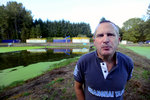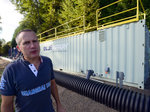



The sleepy city of Vader has become the site of a major innovation — one that could provide an awakening in the way municipalities approach wastewater treatment.
Vader is boasting a new, simpler sewer system that comes at far below the cost the city was expecting.
BlueArray, a Vancouver-based company, last summer installed a containment sewer prototype that functions along with the city’s existing lagoon system.
Victoria Jelderks, the company’s environmental engineer, teamed with entrepreneur, James Reilly, who has a background in computer science from his days in the Silicon Valley, to design the new technology.
But in order to break down existing barriers in an industry dominated by high-priced engineering firms and the bureaucratic red tape that came along with it, BlueArray had to figure out a cost-effective way to essentially give the technology away.
BlueArray is now providing Vader the sewer system for just the cost of operation, using the city as a test site for its wastewater treatment method under the state Department of Ecology’s supervision.
“When it’s free, it changes the dynamic,” Reilly said. “That’s the lesson of Google right. ... If you give something away for free that has value, eventually you're going to be able to build a business model to support it. And people will be very pleased with you.”
Vader officials have called BlueArray’s system a “miracle” for the financially strapped city.
Vader’s lagoon sewer system remained out of compliance with state regulations for years as the city struggled to find a cost-effective solution for wastewater treatment.
Before BlueArray stepped in, Vader was facing options that would have cost up to $10 million and doubled sewer bills for citizens, city officials said.
BlueArray is estimating the cost of the system’s operations to range from $110,000 to $160,000 a year. Vader budgets about $144,000 annually for its sewer, according to city officials.
And for that cost, Reilly said, BlueArray’s system is bringing the community back into compliance after years of consistently failing to meet environmental requirements.
Jelderks began formulating the idea for the technology in her previous job, where she said she grew tired of seeing taxpayers in small municipalities pay for profit-driven engineering firms to come in and sell expensive systems.
“It’s such a sham,” she said. “People should be focused on delivering value.”
Because most of these residents and their elected representatives could not easily understand the scientific language used by the engineers, Jelderks said, the firms could charge inflated prices for services.
“It’s like taxation without representation,” she said. “It’s destroying these small communities.”
While working on an idea to dramatically lower the cost of wastewater treatment, Jelderks met Reilly, who applied the same concept behind server architecture in computer science to her approach.
“The fact that no one from my industry ever came into this industry is the reason these innovations never happened,” Reilly said. “It’s all about flow, either dirty water or electrons that need to be reconfigured.”
But soon after they formulated their idea, he said, Jelderks was fired from her engineering firm for pitching the less expensive technology.
The two then started BlueArray, finding ways to reduce costs by eliminating the infrastructure associated with a traditional treatment plant. Instead of concrete pools and a building, BlueArray uses outdoor lagoons and steel units that contain membrane filters.
Reilly and Jelderks further cut costs by reducing the number of components that comprise the system.
“Because of that we know exactly what each item does and we know exactly how it works,” Reilly said. “The fewer moving parts, the better off you are.”
The company first took the system to Ridgefield and has since refined the process for Vader.
The city’s wastewater is pumped into BlueArray’s steel cargo containers that are filled with 500 membranes, which act like a one-way filters.
Inside the unit, the water is aerated and starved of oxygen, which creates an environment for bacteria to grow. The bacteria then begin converting the wastewater contaminants into solids that can be removed.
“Really, my job is biology,” Jelderks said. “I keep bacteria happy.”
The solids remain inside the BlueArray unit and are converted into food for the bacteria or are vacuumed out. The clean water is pumped into a lagoon.
Once the water reaches the first lagoon, it undergoes a second treatment process where bacteria further attack pollutants.
The water then moves into a second non-aerated lagoon and finally settling pond.
“If you measured the water in the lagoon, it’d be cleaner than the stream,” Jelderks said, noting she still would not drink it.
Vader’s stand-alone lagoon system, Jelderks said, had the capacity to remove 60 to 70 percent of the pollution in the water. But new environmental regulations required removal of 85 percent of the pollutants.
Instead of building an entire new facility, Blue Array simply added four filtration units, which brought the city back into compliance.
Though the long-term effectiveness of the Blue Array system is still being tested, Ecology officials have said the department remains hopeful and appreciates the innovative spirit of Blue Array’s work.